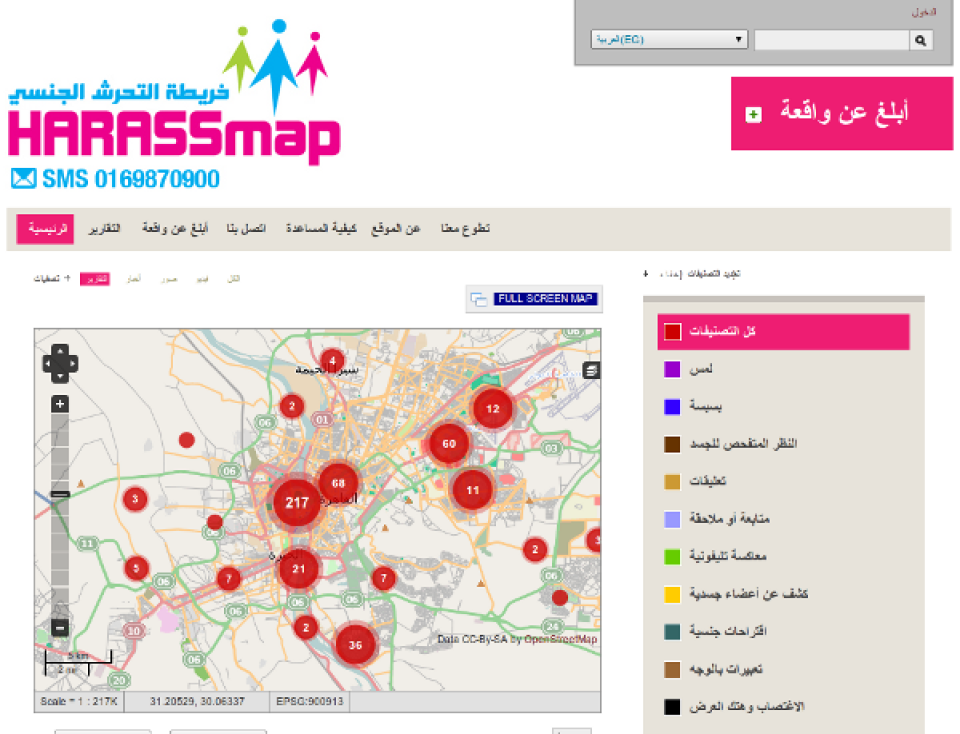
“Map it. End it. Demand change” was the core of the Take Back the Tech! campaign for 2011. There are now several initiatives around the world that aim to map forms of violence against women so as to “put them on the map” in the sense that they are named, pointed out, shown as related, and denounced - and in that way the mapped territory is changed into one that respects the rights of women and children.
“To map our experiences is to demand recognition.
This is the first critical step towards meaningful change."
Take Back the Tech! 2011
Ushahidi: taking action
“Imagine a way that the people of the entire world can directly tell their story of what happens either to them or around them during a disaster or an emergency”, proposed the Ushahidi initiative, which decided to make this idea a reality after the post-electoral violence in Kenya in 2007 [1].
In swahili, “Ushahidi” means “testimony” or “witness”. This is, without a doubt, a key concept. When an act is committed there are direct actors (who share their testimony) and indirect actors (who witness the act). In the face of acts of violence, both types of actors can point to the existence of the act, denounce it, and demand reparation. That is to say, they can map it.
Ushahidi emphasizes that the platform is easy to use, accessible to anyone and deployable worldwide. It is important to emphasize that Ushahidi uses open code, so anyone can modify it for their needs.
To map violence the platform receives information sent online, through cellular phone text messages or videos from smartphones.
Street harassment: Hollaback!
Hollaback! is a movement to end street harassment through the use of cellular phones. Harassment in the street is one of the most common forms of culturally accepted gender violence.
“Hollaback! breaks the silence that has perpetuated sexual violence internationally, asserts that any and all gender-based violence is unacceptable, and creates a world where we have an option—and, more importantly—a response”, as they say on their web site.
“Internet has given us a new campfire. Each time you hollaback, you are given a king-sized platform to tell your story. Thousands will read it and your story will shift their understanding of what harassment means (…) Your story will build an irrefutable case as to why street harassment is not OK. A case strong enough to change the world.”
Sexual harassment in Egypt: HARASSmap
The 2008 study “Clouds in Egypt’s Sky” of Egyptian Center for Women's Rights, revealed that 83% of Egyptian women and 98% of foreign women surveyed said they had been sexually harassed in Egypt, about half of these on a daily basis.
This is why the HARASSmap initiative [2] works on four levels - action, assistance, consciousness and advocacy - to transform the social acceptance of sexual harassment and recover public security for women in Egypt through use of an information system based on text messages (SMS) sent from cellular phones [3].
All the information received by SMS is mapped on a public web site that shows each location and the details provided by the person reporting. According to the group's site: “The map will create a powerful, instantly understandable documentation of the extent of the problem”.
Violence against women and ICTs: Take Back the Tech!
On the first day of the Take Back The Tech! campaign this year a platform was launched for mapping violence against women related to information and communication technologies [4]. The idea was to create collective testimony of violence against women through technology that cannot be ignored, that can be shown for what it is, to say that we do not accept it, to make visible that which is invisible and to document it.
"Although cases of online harassment, cyberstalking, violations of privacy and other forms of technology-related VAW are on the rise, many of these experiences remain untold and undocumented. Their invisibility and our seeming acceptance infect online spaces and practices with a culture that appears willing to tolerate acts of violence against women”, was the warning given on the first daily action of the 2011 campaign.
All of the initiatives mentioned here have in common the goal of documenting violence. Why is documentation important?
Documentation starts a virtuous cycle: give testimony - name the violence - break silence - construct evidence - unite the points - take collective action - affect governments and policies - create strategies for a renewed fight against violence against women - change the map.
“Every story is important”, always stands out in these mapping initiatives. Because we can never forget that all the red points on the map form a pattern that is hard to ignore, though there are some that try to.
---end---
Screen shot of “HARRASSmap” from streetwatch.crowdmap.com
[1] For more information see: http://www.youtube.com/watch?v=z3LNMTSgHDM ; http://www.youtube.com/watch?v=EhT3co2qNAA&feature=related
[2] http://blog.harassmap.org/wp-content/uploads/2010/08/harassmap_executive...
[3] Those who were harassed sexually or witnessed acts of sexual harassment can report it by sending a text message by cell phone (to 0169870900), by sending an email to report@harassmap.org, by tweeting with the tag #harassmap or by completing the form athttp://harassmap.org/reports/submit/
[4] To report cases of violence against women that used ITCsyou can send an email to map@takebackthetech.net, tweet using the tag #takebackthetech or fill in this form https://www.apc.org/ushahidi/reports/submit/
- 7707 views






Add new comment